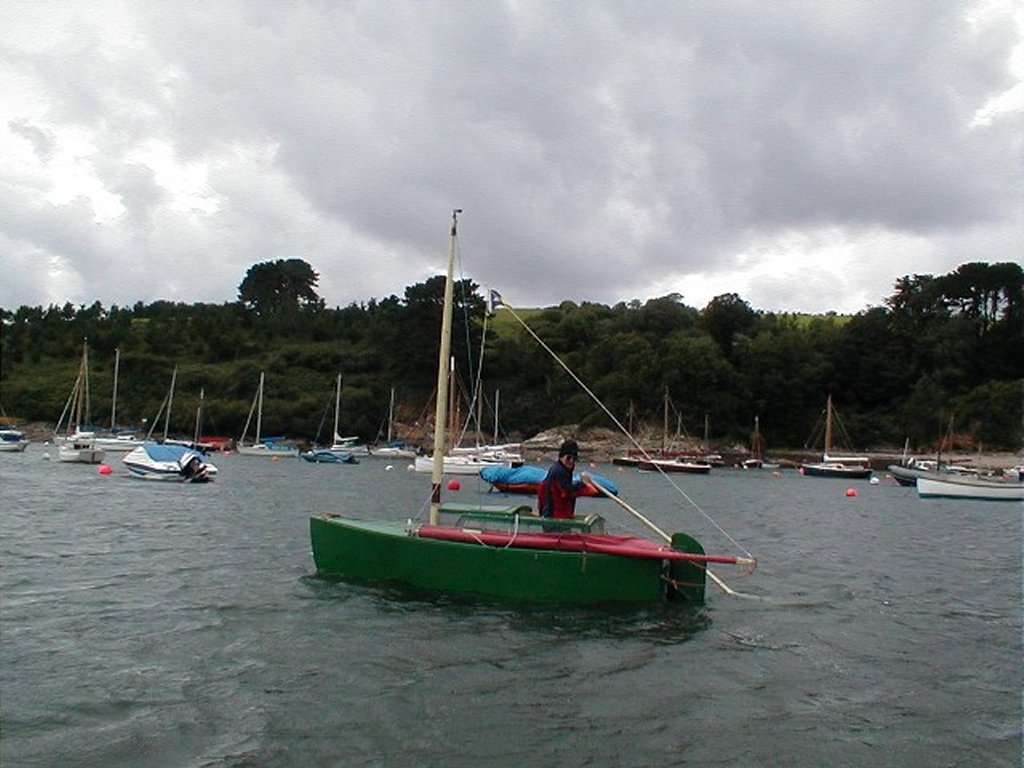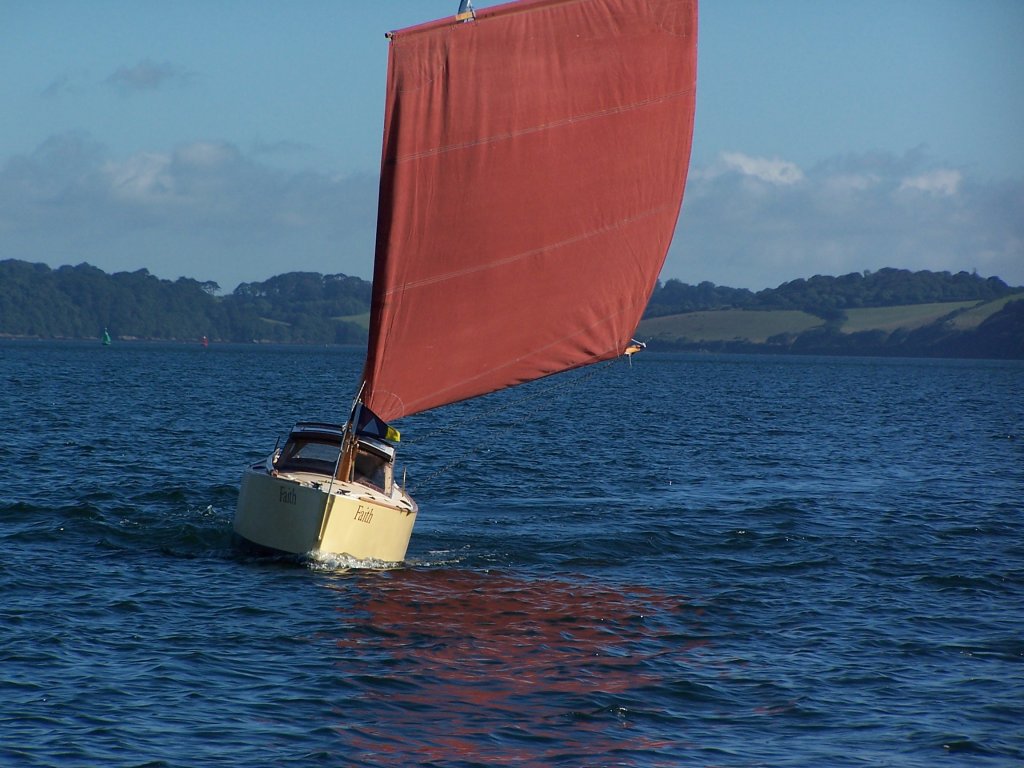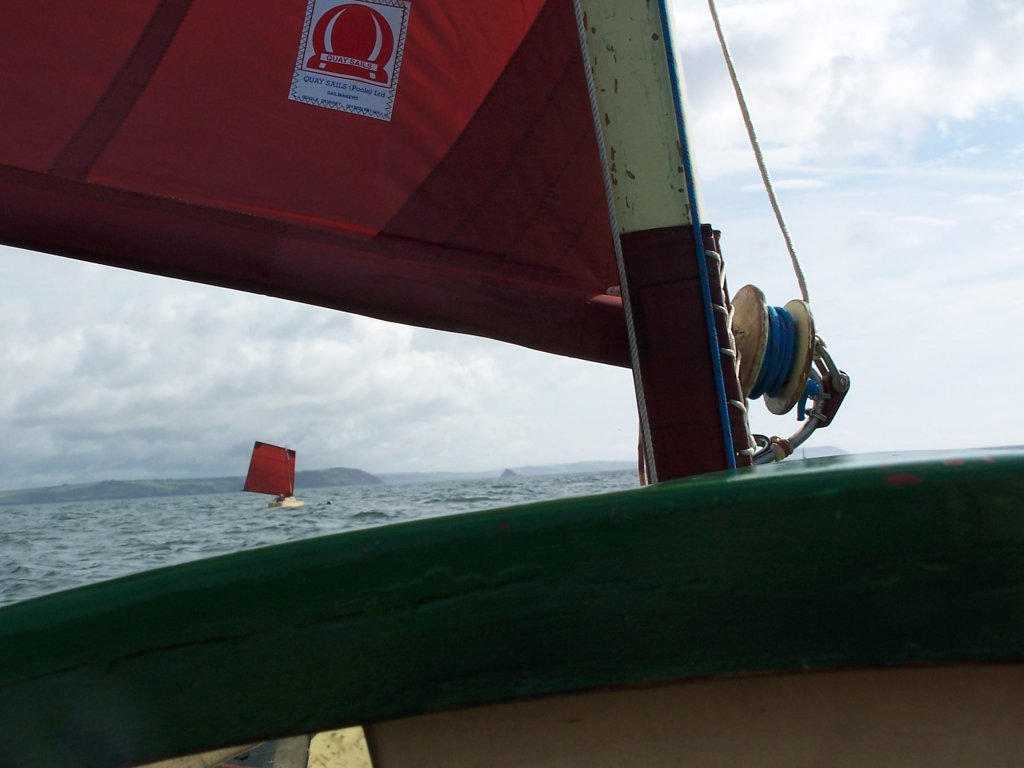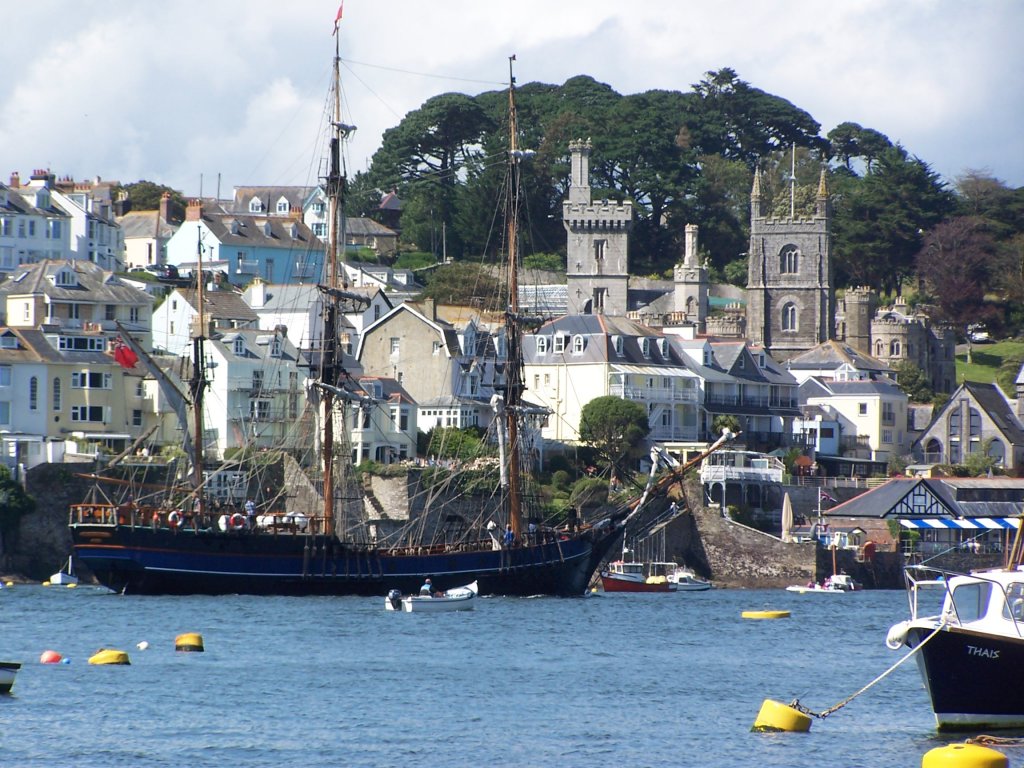In the spring of 2007 Bill Sergeant finished building his Paradox Faith and a sail in company seemed an attractive idea.
This is a report I wrote about the trip for the Dinghy Cruising Association Bulletin.
If you have Google Earth installed on your computer then click here.
If you don't have Google Earth you can download it here
How Scilly can you get?
“We could meet next summer at Falmouth and sail to Scilly”. In the middle of winter it sounded like a good idea. Bill was in the final stages of building his Paradox Faith and the idea of sailing in company was attractive. Bill had been to The Isles of Scilly a number of times in his previous boats and I had 4 years experience in sailing my Paradox Little Jim so we could each be both teacher and pupil.
We decided it would be propitious to start the trip during the DCA North West group meeting at St Just. Everything was arranged, Bill would finish his boat and have a shakedown sail in his home waters on the East coast, then would trail down to the West Country for a short coastal cruise before I joined him at St Just, on Monday, for the big adventure.
Then the weather intervened. Bill got a weekend on the East Coast rivers and was happy with the boat, but a series of lows started rolling in from the Atlantic bringing high westerly winds and rainy conditions to the South West. Bill delayed and finally abandoned his coastal cruise and went straight to St Just, where I joined him a few days later.

Finding an anchorage at St Just
The launch site at St Just is a stony beach. With a boat as heavy as the Paradox it is necessary to manoeuvre the trailer with the car, man-handling the rig is just not an option. With sufficient rise of tide the launching was easy, but I had problems moving the empty trailer back up the beach, my front wheels digging themselves into the stones. I did manage to get the trailer back up the beach without assistance but doubt if I could manage it unaided with the boat as well. It turned out that Bill was of the same opinion with his boat, and this may have had some bearing on our later decisions.
The forecasts continued to predict strong SW winds and rain, but while we were hanging about waiting for a more easterly wind we did get across to Helford one day, and spent the night on the sailing club pontoon before returning the next day. The day after that was terrible so we went ashore to Truro and Falmouth.

Helford here we come
Finally we gave up waiting for suitable weather for heading west to The Isles of Scilly and decided that going east had a lot of merit. On Saturday at 0700h, with a forecast of “W backing E F3-4, rain”, we set off for Fowey. It took us an hour and three quarters to beat out of the entrance of the Fal estuary and round St Anthony Head, but then it was a glorious run all the way to Fowey.
While crossing Gerran’s Bay we heard, on the VHF, a catamaran telling the coastguard that he was in the middle of the bay and had a rope round his prop. The coastguard put out a request for any boats in the vicinity to call in, but when informed we had no engines decided we would probably be of no help. Eventually the ILB came out and helped them.
At this time we found that our boats were so well matched that we could sail together within easy shouting distance. It was while sailing along, 20 metres from Faith, in the bright sunlight, that I realised that this was what I came boating for. We were slipping along smoothly, heading gently towards our destination, with nothing to do but watch the land and the sea drift past and I knew that, when I came to write this report, I would never be able to find the words to express my utter contentment. So you must just take it as read, I was relaxed and happy!

It doesnt get better than this
We rounded Dodman Point near slack water, and then had the tide against us for the rest of the day, but this had little obvious effect on our progress. Just after Dodman Point I saw a small fin in the water ahead. At first I thought it might have been a turtle’s flipper or some sort of small shark, but as it passed about ten feet away I was able to identify it as a Sun Fish, the first live specimen I have seen.
Our entry into the Fowey River estuary was uneventful and we tucked round off Polruan where we each picked up a mooring. Bill was disturbed twice as the owners of the moorings returned, but he eventually found one that stayed unclaimed. We stayed there the next day as the weather was again wet and windy, but went for a walk in the afternoon.

Neighbors at Fowey
There is a launching slip at the car park, next to the ferry slip, on the Fowey side. We walked up there and had a good look at it as, if we could get no further east we would be lifting the boats out there. The slip looked in reasonable condition and with the car park right next to it there would be no difficulty finding space to de-rig the boats. Fortunately, as it turned out, we had no need for it.
On Monday the forecast was “S F3-4 increasing F5-6 for a time, showers”. In fact every forecast predicted rain or showers, but on the days when we sailed it was almost totally dry. We decided to go out and have a look at the conditions then make a decision whether to continue. With the southerly wind we would have no difficulty in getting back in. We did, however, have to work quite hard to get out against both wind and the last of the tide. Once out we decided that, though the sea was still a bit lumpy, the wind was right for a reach across to Plymouth. By the time we arrived at Rame Head the tide was flowing hard against us and the wind had dropped to F3 so it was slow going to get round. At one point my speed over the ground (SOG) was only 1.2 knots. While fighting the tide I heard a call for assistance from a 40 foot yacht “2.5 miles SE of Great Mewstone” which had engine failure and “as there was insufficient wind was just drifting”(!) It occurred to me that as the tide was west-going it would be drifting into Plymouth harbour. However the lifeboat came out and took it in tow, at which point the wind increased to a good F4.
There was too much south in the wind for Barn Pool to be sheltered, though we went and had a look anyway, so we continued on up past Cremyll and round into Millbrook Lake. The tide was rushing in so there was no difficulty making headway, but then we tried to cut the corner into Millbrook lake. The trees and buildings on the Cremyll shore almost completely blanketed the wind and I was much surprised to find that the tide was flowing swiftly out of Millbrook Lake. A back eddy I suppose. I eventually gave up fighting it and went back into the main stream and took the long way round, entering Millbrook Lake from the north. In the morning, after a quiet night on the mud, the outgoing tide whisked us though without any problems.
We had again decided to head out to test Tuesday’s forecast with direct observation. The forecast in question was “SW F5-6 decreasing F3-4, showers”. While crossing the Sound I measured the wind to be F4 and, once outside the breakwater, we decided to continue, even though there was a large swell coming in. As we continued across Bigbury Bay the wind increased, and with it the swell. It must have been at least 3m and at times the whole of Bill’s sail was lost from view as he descended into a trough. It was around this time that one of the waves got a bit too friendly and decided to join me in Little Jim. I took the hint and switched to secure mode, with the hatch shut. Then the sun came out and the cabin began to resemble a sauna as I slowly steamed. I was very pleased to realise later that this was the first time that I hadn’t been sea-sick when forced to sail from inside. These were undoubtedly the worst conditions I have ever been out in with the sea being even more confused, off the headlands, by the swell bouncing off the cliffs. We both agreed later that if we had known how rough it was going to get we would not have gone out. Yet throughout the boats never felt overstressed and just carried on sailing under full control. A very comforting demonstration of their seaworthiness.
Our entrance into Salcombe was interesting as it was near low water and I could see the waves breaking on the eastern side of the infamous bar. Fortunately in the channel, although the waves were rearing up, they weren’t breaking and we got in without incident. The Harbour master said we were the only boats to come in that day, then he charged us £3.60 each Harbour dues. Salcombe has an excellent slipway to the north of the town, in Batson Creek. We knew we could lift the boats out there, but by now were determined to travel as far east as possible before my time ran out.
It is a feature of the Paradox that whenever we stop somewhere someone will come and tell us what interesting looking boats they are. Here was no exception as at least 6 groups queued up to ask us the standard questions. Later when we bought a pasty to eat on the quay we could see more people having a good look. The discussion soon became more animated, however, when DCA member Dave Morl turned up. He was on holiday in the area and had happened to see us sail in.
We dried out for the night on South Sands beach so as to be able to get a quick start on Wednesday morning. I have often dried out at DCA meets and didn’t expect any problem, this time however the residual swell from the south west was translating into waves which were breaking about 9 inches high. As the wave passed the backwash swung the boat broadside on to the next wave making the whole process rather uncomfortable. There was no worry about the boats getting damaged as the Paradox is so sturdily designed but it was uncomfortable for a while. We should, of course, have put out a shoreside anchor to hold us head to sea. At about 0400h Bill was up and about and thoughtfully moved our anchors further down the beach so that we were able to pull into deeper water as soon as the (3 inch) waves lifted us off in the morning at 0615h.
The anchors came up at 0655h and we sailed and rowed clear of the fluky, and sometimes non-existent, wind in the harbour entrance getting into clear air by 0730h. The forecast was “SW F3-4 becoming variable F3 or less” and we wanted to be sure of clearing Start Point before the tide turned, and hoped to get as far as Brixham. We needn’t have worried. We bounded along, rarely dropping below 5 knots SOG. We gave both Prawle Point and Start Point a good clearance and saw no rough water, though somewhere round Start Point my GPS recorded my highest SOG of 8.1 knots!
The wind held across Start Bay but began to drop off as we approached Berry Head and once round the head dropped completely forcing us again to get out the yulohs. This was one of the hottest days of the trip (again the forecast rain didn’t show up) and by the time we got to Brixham Yacht Club pontoon, over 2 hours later, I was ready for a long drink.
The visitors pontoon at the Yacht Club is not connected to the shore and we were just debating whether to move round to the marina when a gentleman rowed past on his way to his yacht for a quick sail before dinner time. “Those are interesting looking boats” he said, and a conversation ensued in which he offered to give us a lift ashore. Then, while he went off for his sail and we prepared what we needed to take ashore, a 31 foot Moody tied up to the pontoon and a friend of theirs came out from the shore. Suddenly we had two more offers of a lift, and the friend told us to use his dinghy and leave it on the pontoon in the morning, where he would collect it. The Moody skipper took delight in telling me how this friend was interested in sailing small boats and had once “spent a whole week sailing Poole harbour living aboard a mirror dinghy”. I wondered what the skipper would make of the DCA. We had an excellent shower and a splendid meal at the Yacht Club and spent a quiet night on the pontoon, disturbed only by the pilot boat going out at about 0600h.
There are a couple of good slipways in Brixham harbour, one just near the Yacht Club, but Exmouth is just up the coast, well within reach, and we had decided that there was where our cruise should finish.
Thursday morning’s forecast was “variable F3 or less becoming NW F4 later, showers”. It turned out to be another hot day (no showers) and the wind in Tor Bay was definitely less than F3. We started off at 0712h rowing out in a flat calm. It wasn’t until 0850h, some 2 miles later, that the wind put in an appearance, coming from north of east. Once clear of the coast this was sufficient to allow us to make Exmouth in one tack. However it varied in strength giving maximum speeds of 2 to 3 knots, but sometimes less than 1 knot. When this happened out came the yuloh again.
By some mental incapacity in both of us we had convinced ourselves that high tide would be at 1730h and had decided to cut inshore round Dawlish Warren, thus saving about 3 miles. We were surprised therefore to discover, when we finally reached the Pole Sands at 1540h that there was little water (1730h was, of course, low water). We managed to negotiate one sand bar by jumping overboard and pulling the boats through with sails still set. On looking back, a couple of hundred yards later, the sand was clear of the water. All this effort tuned out to be futile, however, as I ran hard aground just short of the main entrance channel. And, had we got across, the outgoing tide in the channel would have defeated us. So we dropped the anchors and settled onto the flat sand while we cooked a meal. The water was streaming past us at a considerable rate yet, before Bill grounded, while he was setting the anchor, I was holding his boat and was surprised how little load there was on the line. These are very slippery boats. Before dinner was finished we were afloat again with the water now rushing past the other way. We sailed into the harbour on the dying breeze and, as the tide rose, moved up to anchor near the slip.
The next day, Friday, we returned to St Just by train, ferry and foot to retrieve our cars and trailers and brought them back to Exmouth, only to discover that Faith had been left, by the falling tide, sitting on a mooring block with an iron loop on top. The obstruction was almost under the balance point and, with the rudder on the ground, left the bows some 2 feet in the air. She floated off with the rising tide and it was found later that, due to the strength of the Paradox construction, no damage had occurred. In fact it was not possible to identify where the contact point had been!
The slip at the Exmouth recreation ground only reaches the water for about 2 hours either side of high water, though it is possible to launch across the sand which is firm enough to drive over. When the water does reach the slip there is a significant cross tide. However, even with these drawbacks it is a good slip to use, having a good non-slip surface, and space allocated for trailer parking and boat preparation. There is a long stay car park by the station, a couple of hundred yard away, where weekly tickets can be bought.
The next morning the boats were recovered, Little Jim as soon as we floated and Faith when there was enough depth to float onto the trailer, and it only remained for us to drive home for our “Scilly trip” to be well and truly over. Easy for me as I live only an hour away, but a 7 hour ordeal for Bill including torrential rain, accidents and breakdowns, as well as the holiday traffic because children were now off school. Our sailing included a wide variety of conditions varying from almost too rough to almost too calm, and we didn’t get to our intended destination, but we had a tremendously enjoyable time and that’s what matters in the end. Besides as Bill said “We could meet next summer at Falmouth and sail to Scilly”.
Some statistics:
Total distance travelled 140.39 nautical miles.
Total time travelling 58 hours 26 minutes.
Maximum speed 8.1 knots.
Average speed (including travel in harbours) 2.4 knots.
Number of paperbacks read 2.8, an average of 5.4 pages/mile.
Introduction




